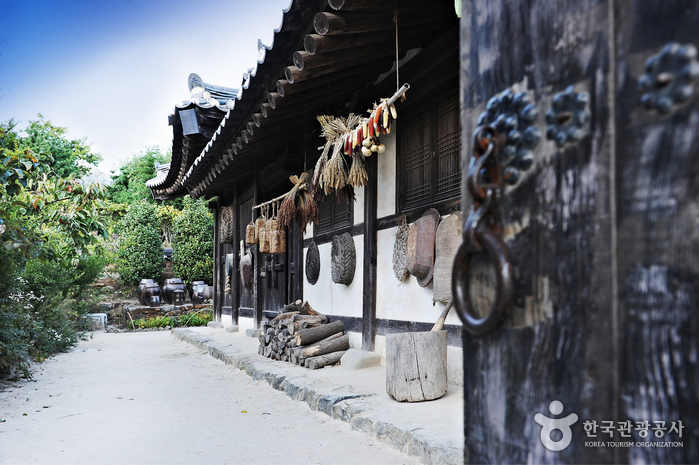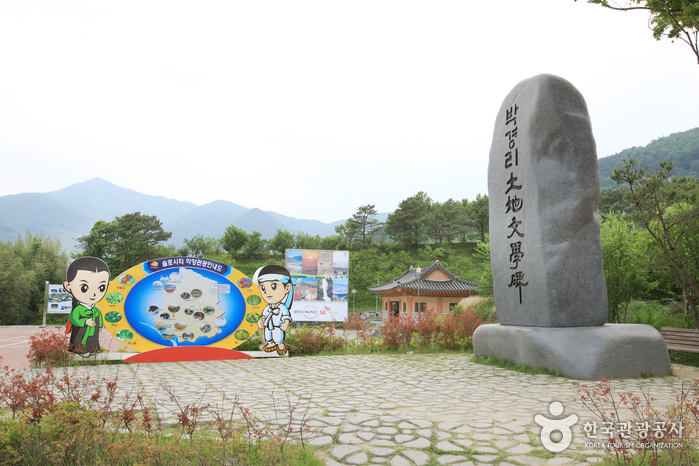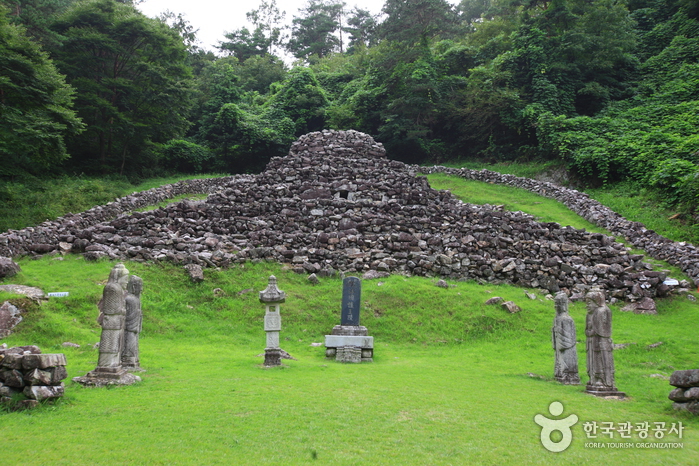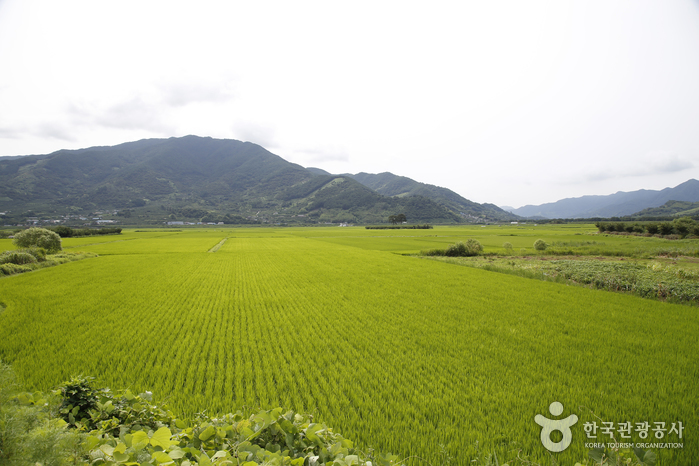Choi Champandaek (House of Choi Champan) (최참판댁)
18.9 Km 29016 2021-12-16
66-7, Pyeongsari-gil, Hadong-gun, Gyeongsangnam-do
+82-55-880-2651
The House of Choi Champan is known as the setting of the famous novel "Toji" ("The Land") by noted novelist Park Kyongni. Located in a small folk literature village in Agyang-myeon, Pyeongsa-ri along the Seomjingang River at the foot of Jirisan Mountain, Choi Champandaek consists of fourteen hanok (traditional Korean house) buildings.
Also used as the main set of the drama version of "Toji" (2004), Choi Champandaek gives visitors a look at the life of Korean people in the late Joseon era. The house has not only made its appearance in many films, but is also a valuable cultural asset of Hadong-gun.
The Daecheong Maru (wooden-floored hall) connected to the Sarangchae (men’s quarters in a hanok) offers a wide view of the vast field of Pyeongsa-ri and gives an opportunity to meditate and reflect while appreciating the beautiful surroundings. Located in the vicinity are numerous tourist attractions including the Pyeongsari Literature Center, Hwagae Market, and Ssanggyesa Temple. During fall season every year, Choi Champandaek hosts the Toji Literature Festival.
House of Choi Champan [Korea Quality] / 최참판댁 한옥숙박시설 [한국관광 품질인증]
18.9 Km 4 2024-06-28
75 , Pyeongsari-gil, Hadong-gun, Gyeongsangnam-do
+82-10-2086-5330
House of Choi Champan is a hanok stay in Pyeongsa-ri, Akyang-myeon, where the Seomjin River flows down from Jirisan Mountain, Jeollanam-do. The accomodation is in several different configurations: the two-storey Ilyeongjae and Wolyeongjae are both rented out as houses; Yeonhajae and Hoeramjae, which are single-storey with numaru(a raised open floor); while Unrakjae and Hoegyeongjae have several rooms with bathrooms, each rented out. Only the "Hoegyeongjae-1" room is equipped with Numaru. Cooking strong-smelling food in guestrooms is not allowed.
Toji Literature Festival (토지문학제)
18.9 Km 848 2020-09-17
76-23, Pyeongsari-gil, Hadong-gun, Gyeongsangnam-do
• 1330 Travel Hotline: +82-2-1330 (Korean, English, Japanese, Chinese) • For more info: +82-55-880-2363
Toji Literature Festival is held annually in Hadong-gun, the setting of one of Korea's greatest historical novels, Toji, written by Park Kyongni. The festival pays tribute to the novel Toji, depicting the modern history of Korea between the years of the Donghak Revolution in 1897 and the Liberation of Korea in 1945. It has become one of the nation’s major literature festivals.
Yeoneu [Korea Quality]여느[한국관광 품질인증]
19.0 Km 1 2023-05-23
116-68 , Cheonbyeon-gil, Gurye-gun, Jeollanam-do
+82-10-7353-1802
Pension Yeoneu in Gurye, Jeollanam-do, stands on the site where Korean independence activist Wang Jae-il was born. The mint-green roof gives the place a fairy tale feel, while inside it’s friendly and welcoming. The pension is let out as a single house, which includes an annex building with a large bathtub, a sunroom, and a sun deck. Throughout the house, guests will notice vintage items collected from the owner’s travels in the US, Europe and Korea.
Starway Hadong Healfort[Korea Quality] / 힐포트하동[한국관광 품질인증]
19.4 Km 0 2024-06-25
3352-1 , Seomjingang-daero, Hadong-gun, Gyeongsangnam-do
Hadong Healfort, situated halfway up the mountain in Akyang-myeon, Hadong, Gyeongsangnam-do, is located near Pyeongsa-ri, which is the setting of the novel Toji, and offers a panoramic view of the Seomjingang River. In the living room, the view from the window is as lovely as a framed picture. There are 13 guestrooms, divided into three types: double, twin, and ondol (underfloor heated), each with a living room, bedroom, bathroom, and private terrace. This is an ideal location for couples to relax and enjoy the view.
Tomb of King Guhyeong, Sancheong (산청 전 구형왕릉)
19.5 Km 18145 2020-06-30
Guhyeongwangneung-ro, Sancheong-gun, Gyeongsangnam-do
+82-55-970-6411
This stone grave is known to be the tomb of King Guhyeong, the 10th King of the Gaya Kingdom. He is also known as King
Guhae or King Yang, and is the grandfather of Kim Yoo Shin. Since becoming
the King of Gaya in 521 AD, he reigned for 11 years until he handed over his
country to King Beopheung of the Silla Kingdom in 532 AD.
There are two
different scholarly opinions about this tomb. One is that it should be classified as a stone pagoda and the
other, a royal tomb. The reason why this was regarded as a pagoda is
that there are similarly shaped stone pagodas in the Andong and Uiseong regions.
The basis for it being called Wangreung, or royal tomb, is that there is a record in Dongguk Yeoji Seongram (an
ancient history book published during the rule of King Seongjong in the Joseon dynasty) and
in Saneum-hyeon Sancheonjo (a record of events in the region) of it being a
tomb. The
notes state that "there is a structure with steps on
the four faces, in the form of nine dragons piled up of stones at a distance
of about 16 km (40 ri in traditional Korean scale) from the village, so
people believe it must be a royal tomb".
The record describing the name of the king buried
in this tomb can be extracted from a record of travels called Wangsan Shimreunggi
written by Hong Ui Young, a Joseon dynasty scholar. In addition, there’s also
an entry in Wangsansagi, a book on the history of Wangsansa Temple (a
temple located west of the tomb) that the person buried in the tomb is King Guhyeong.
Unlike ordinary
graves, the tomb is built at the middle part of the hill's slope. The tomb
has a unique appearance made up of steps and layers, with the highest point
being 7.15 meters high. There are seven layers at the front and no steps at
the back due to it being built on an inclined surface. The overall shape of
this tomb is different from the pyramids built on level ground. The top of the tomb is oval in
shape. At the center, there is a stone tablet with the words "Royal Tomb of King Yang of the
Garak Nation". In front of the tomb, there are several stone pieces that
have been added to the original tomb.
During the 17th Year of King
Jeongjo of the Joseon dynasty (1793), a wooden box that was passed down from generation
to generation in Wangsansa Temple was discovered. The box contained portraits
of King Guhyeong and his queen, their clothes, an archery bow, and other objects. To
preserve these, a royal building called Deogyangjeon Hall was
constructed. To this date, a memorial service is held here in spring and
autumn of every year.
Pyeongsari Field (평사리들판)
19.7 Km 29471 2022-08-26
Pyeongsari-gil, Hadong-gun, Gyeongsangnam-do
+82-55-880-2651
Pyeongsari Field was created by Seomjingang River flowing through the canyon which attracted people to form a village. The field served as the central farming field and fed the villagers for many years and appeared as a setting in Park Kyongni's novel "Land." Pyeongsari field is one of the largest fields found along Seomjingang River, boasting a size of 2,743,801 ㎡.

![House of Choi Champan [Korea Quality] / 최참판댁 한옥숙박시설 [한국관광 품질인증]](http://tong.visitkorea.or.kr/cms/resource/77/2709977_image2_1.jpg)

![Yeoneu [Korea Quality]여느[한국관광 품질인증]](http://tong.visitkorea.or.kr/cms/resource/34/2949134_image2_1.jpg)
![Starway Hadong Healfort[Korea Quality] / 힐포트하동[한국관광 품질인증]](http://tong.visitkorea.or.kr/cms/resource/64/2811864_image2_1.jpg)


 English
English
 한국어
한국어 日本語
日本語 中文(简体)
中文(简体) Deutsch
Deutsch Français
Français Español
Español Русский
Русский